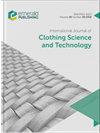Development of a dedicated process simulator for the digital twin in apparel manufacturing: a case study
IF 1
4区 工程技术
Q3 MATERIALS SCIENCE, TEXTILES
International Journal of Clothing Science and Technology
Pub Date : 2024-05-16
DOI:10.1108/ijcst-01-2024-0017
引用次数: 0
Abstract
PurposeThe purpose of this study is to introduce a dedicated simulator to automatically generate and simulate a balanced apparel assembly line, which is critical to the digital twin concept in apparel manufacturing. Given the low automation level in apparel manufacturing, this is a first step toward the implementation of a smart factory based on cyber-physical systems.Design/methodology/approachThe mixed task assignment algorithm was implemented to automatically generate a module-based apparel assembly line in the developed simulator. To validate the developed simulator, a case study was conducted using process analysis data of technical jackets obtained from an apparel manufacturer. The case study included three scenarios: calculating the number of workers, selecting orders based on factory capacity and managing unexpected worker absences.FindingsThe developed simulator is approximately 97.2% accurate in assigning appropriate tasks to workstations using the mixed task assignment algorithm. The simulator was also found to be effective in supporting decision-making for production planning, order selection and apparel assembly line management. In addition, the module-based line generation algorithm made it easy to modify the assembly line.Originality/valueThis study contributes a novel approach to address the challenge of low automation levels in apparel manufacturing by introducing a dedicated simulator. This dedicated simulator improves the efficiency of virtual apparel assembly line generation and simulation, which distinguishes it from existing commercial simulation software.开发服装制造数字孪生专用流程模拟器:案例研究
目的本研究旨在引入一种专用模拟器,用于自动生成和模拟平衡的服装装配线,这对于服装制造中的数字孪生概念至关重要。鉴于服装制造业的自动化水平较低,这是实现基于网络物理系统的智能工厂的第一步。设计/方法/途径在所开发的模拟器中采用混合任务分配算法自动生成基于模块的服装装配线。为了验证所开发的模拟器,利用从一家服装制造商处获得的技术夹克工艺分析数据进行了案例研究。案例研究包括三个场景:计算工人数量、根据工厂产能选择订单和管理工人意外缺勤。研究结果开发的模拟器在使用混合任务分配算法为工作站分配适当任务方面的准确率约为 97.2%。该模拟器还能有效支持生产计划、订单选择和服装装配线管理方面的决策。此外,基于模块的生产线生成算法使装配线的修改变得非常容易。 原创性/价值 本研究通过引入专用模拟器,为解决服装制造业自动化水平低的难题提供了一种新方法。该专用模拟器提高了虚拟服装装配线生成和模拟的效率,使其有别于现有的商业模拟软件。
本文章由计算机程序翻译,如有差异,请以英文原文为准。
求助全文
约1分钟内获得全文
求助全文
来源期刊
CiteScore
2.40
自引率
8.30%
发文量
51
审稿时长
10 months
期刊介绍:
Addresses all aspects of the science and technology of clothing-objective measurement techniques, control of fibre and fabric, CAD systems, product testing, sewing, weaving and knitting, inspection systems, drape and finishing, etc. Academic and industrial research findings are published after a stringent review has taken place.

 求助内容:
求助内容: 应助结果提醒方式:
应助结果提醒方式:


